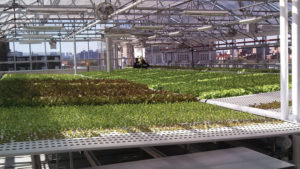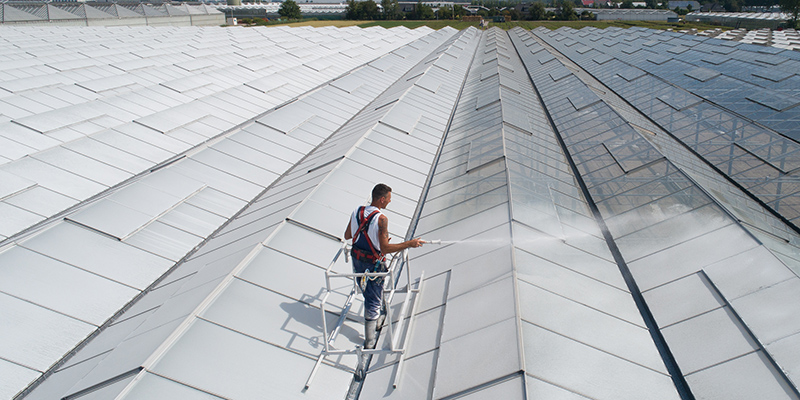Greenhouse Vegetable Production Systems for Every Grower

The right vegetable production system for you is the one that helps you manage your crops effectively while keeping production costs down. Photo courtesy of AmHydro.
Greenhouse vegetable production has never been easy. With rising production costs, expanding environmental regulations, and a diminishing labor force, now more than ever growers are forced to be innovative. Thankfully, growers have an increasing number of tools at their disposal.
“There is no one-size-fits-all method; I have seen many growers producing great crops in different ways,” says Joe Swartz, Vice President at AmHydro and a controlled environment agriculture consultant who has more than 30 years of hydroponic growing experience.
“We have all these available tools and technologies, so it’s about finding the right fit. The results are what counts.”
Swartz says the key to any growing system, however, is two-fold. The systems need to be based in sound horticultural production techniques, and they need to be efficient. When it comes down to it, he explains, controlled environment agriculture is a real estate game. Growers will always be limited by their production space. The right system will help them manage it effectively while minimizing production costs.
Here are some options for growers to consider for growing vegetables.
NFT and Hydroponics Systems
NFT technology has come a long way. While the traditional method uses channels to stream water and dissolved nutrients directly to plant roots before recycling and recirculating the unused materials, most commercial greenhouses have taken the basics of this system and made improvements.
According to Rough Brothers’ Tom Vezdos, one option for making improvements that helps eliminate some of the labor issues that can sometimes be associated with traditional NFT, is a fully automated system that uses conveyors and lifts to move the crops through the different stages of the cycle, from germination to harvest.
Vezdos also likes deepwater culture (DWC) systems. DWC is sometimes called hydroponics in its purest form, as it doesn’t require growing substrate growing. The plants roots dangle directly into pools of nutrient-rich aerated water.

Oasis Grower Solutions’ Horticubes, with their enhanced biodegradable properties that don’t affect plant performance, are one example of advancements in hydroponic media. Photo courtesy of Oasis Grower Solutions.
“Nowadays, there’s automation that allows growers to eliminate the need for people,” he says, adding that DWC with a raft system works well in a large-scale operation. “The benefit is that DWC has a mass of water and isn’t susceptible to whether a pump is running. If there’s a mechanical issue, the system maintains its integrity. You simply push the rafts to where you’re doing the work.”
While traditional NFT systems are primarily for leafy greens and herbs, bucket and vine crop systems offer a closed-loop system for larger root crops like tomatoes, peppers, cucumbers, and eggplants. In these systems, the roots are contained in a soilless media instead of a channel. Swartz says these systems used to be “drain to waste,” but ones like AmHydro’s now close the loop and recycle the unused nutrients.
Even hydroponic growing substrate has gotten more advanced. Oasis Grower Solutions, for example, offers a hydrophilic foam medium that contains starter nutrients, an Easy Plant system of products that include the plug, block, and slab for hydroponic crops such as tomatoes, and one-bag hydroponic fertilizer.
“Hydroponics will see explosive growth in the next few years,” says Oasis Global Marketing Manager Jeff Naymik. “As the cost/value of land increases, governmental changes and global demand will put pressure on growers to increase turns in less space while increasing the yield per square meter.”
NFT and their upgraded counterparts have obvious benefits, but as with any system, there are drawbacks, as well. Automation is not cheap, and there’s an ongoing debate about whether the NFT-grown vegetables could ever be as tasty as their field-grown counterparts.
For those who want to grow organic, however, the biggest con is that substrate media can’t meet the standards for certification. Ryan explains that fertilizer can also pose a problem since natural animal by-products like cow manure could expose the produce to animal-based diseases, but synthetic options won’t meet organic certification requirements.
Vertical Growing Systems
For some growers, the future of farming is vertical. This growing method turns traditional production methods on their sides, stacking plants on top of one another to better optimize space.
At the 2017 Global Innovations in Horticulture Seminar, Wageningen University’s coordinator innovative technologies and guest speaker Frans Kampers identified another promising feature: The innovative technology is getting young people interested in the green industry.
Kampers says there are parts of the world where it is very difficult to get young people to take over the farm. If we can include more technology, it will involve less heavy work and will be more interesting for young people to do.
Still, some experts remain skeptical that the technology delivers on its promises.
“The problem with tower systems is that you’re always robbing Peter to pay Paul,” Vezdos says, adding that even with innovations in light wave diffusion technologies, there will always be a portion of the tower that’s shaded. “Growers are going to struggle with uniformity issues.”
Swartz agrees vertical technologies aren’t as promising as they sound. He says he was fooled until he ran tests and closely examined the data. In his recent LinkedIn article (Going Vertical to Increase Your Yields? Let’s Look at the Realities. You might be Surprised!) on the topic, Swartz found that in a 30-foot-by-96-foot greenhouse, horizontal NFT channels produced 10,368 plants compared to 6,456 plants in vertical towers in the same space.
Finding the Right System
So, what’s the best system for growing produce? It depends. Growers need to ask several questions to get to the perfect solution. Geography, crop type, desired level of automation, and budget all play a role in what system makes sense.
Another important thing to consider is the end product. A technique that works well for tomatoes might not be the best for a cut salad mix. Manufacturers are willing to work with growers to build the best systems for their operations, and many offer technical support to ensure employees know how to properly use the equipment. Ultimately, though, there’s no perfect system.










